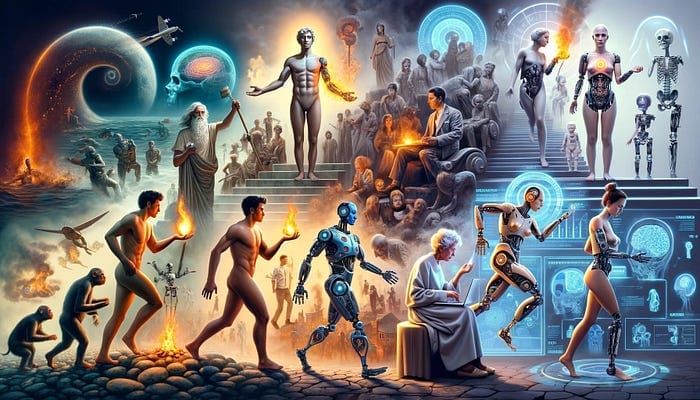The Integration of AI into Bionics

The aspiration to exceed our natural limitations has been a constant companion in human evolution. From the mythological endeavors of Prometheus to the technological marvels of the modern era, humanity has relentlessly pursued the means to enhance its capabilities. Integrating Artificial Intelligence (AI) into bionics marks a significant milestone in this journey, heralding an era where the augmentation of human abilities is not only conceivable but increasingly attainable. This short essay explores the multifaceted dimensions of AI’s integration into bionics, reflecting on its historical roots, technological advancements, ethical considerations, and societal transformative potential.
While popularized in the 1950s, the concept of bionics draws on a rich tapestry of human history and mythology. Ancient civilizations envisioned beings of enhanced capabilities through their gods and myths, foreshadowing today’s endeavors in human augmentation. This historical backdrop underscores a fundamental human trait: the quest to push beyond our inherent boundaries.
The convergence of disciplines — AI, motor technology, material science, and neurology has set the stage for unprecedented advancements in bionics. These technologies are no longer confined to restoring lost functions; they aim to elevate human capabilities. This vision is central to eradicating disability, transforming what was once deemed a limitation into untapped potential. The goal is ambitious yet profoundly human: to create a future where technological innovation renders disability a distant memory.
AI and machine learning stand at the forefront of this revolution, offering physical enhancements and cognitive and performance augmentations. In competitive sports, AI-driven analytics and real-time data collection are not mere tools but game-changers, enabling athletes to surpass their natural abilities. Yet, the application of AI in bionics extends beyond the sports field, touching on life-saving interventions, such as aiding firefighters through augmented reality technologies that pierce through the veil of smoke, illuminating paths to safety.
However, integrating AI into bionics is not without its ethical and philosophical quandaries. It compels us to ponder the limits of enhancement: How far should we transcend our natural capabilities? In their essence, do imperfections contribute to the richness of human experience? These questions invite a reflective examination of what it means to be human in an age where technology blurs the lines between the natural and the artificial.
Trust in AI emerges as a central theme in this narrative. As AI systems grow increasingly sophisticated, convincing society of their reliability, especially in critical decision-making scenarios, becomes essential. The balance between leveraging AI for its unequaled insights and maintaining human oversight is delicate, necessitating a nuanced approach to integration.
Beyond the philosophical and ethical considerations, AI-integrated bionics have a transformative potential for society. This technology is not merely about enhancing the individual; it represents a shift in societal norms and the potential to redefine human interaction, productivity, and creativity. The prospect of extending human expression beyond physiological functions such as jumping higher, running faster, and thinking deeper speaks to a future where the boundaries of human capability are continually reimagined.
Integrating AI into bionics embodies the human quest to extend beyond our natural confines. It promises a future where disability is obsolete and human potential is limitless. However, navigating this future requires careful consideration of ethical, social, and technical challenges. Standing on the cusp of this new era compels us to guide this technological evolution with wisdom, ensuring that the augmentation of human abilities enriches the human experience rather than diminishing it. Our most excellent guide in this journey is the profound understanding that while technology can enhance our capabilities, our shared humanity truly defines us.
Join Us Towards a Greater Understanding of AI
I hope you found insights and value in this post. If so, I invite you to become a more integral part of our community. By following us and sharing our content, you help spread awareness and foster a more informed and thoughtful conversation about the future of AI. Your voice matters, and I’m eager to hear your thoughts, questions, and suggestions on topics you’re curious about or wish to delve deeper into. Together, we can demystify AI, making it accessible and engaging for everyone. Let’s continue this journey towards a better understanding of AI. Please share your thoughts with me via email: marty@bearnetai.com, and don’t forget to follow and share BearNetAI with others who might also benefit. Your support makes all the difference.
Thank you for being a part of this fascinating journey.
BearNetAI. From Bytes to Insights. AI Simplified.
Categories: Science and Technology, Ethics and Philosophy, Health and Medicine, Sociology, Sports Science, Innovation and Future Studies, Disability Studies
The following sources are cited as references used in research for this BLOG post:
Homo Deus: A Brief History of Tomorrow by Yuval Noah Harari
The Singularity is Near: When Humans Transcend Biology by Ray Kurzweil
Superintelligence: Paths, Dangers, Strategies by Nick Bostrom
Bionics for the Evil Genius: 25 Build-it-Yourself Projects by Newton C. Braga
Enhancing Human Capacities, by Julian Savulescu, Ruud ter Meulen, and Guy Kahane
Wired for War: The Robotics Revolution and Conflict in the 21st Century by P.W.
Mind Children: The Future of Robot and Human Intelligence by Hans Moravec
The Body Electric: How Strange Machines Built the Modern American by Carolyn Thomas de la Peña
© 2024 BearNetAI LLC